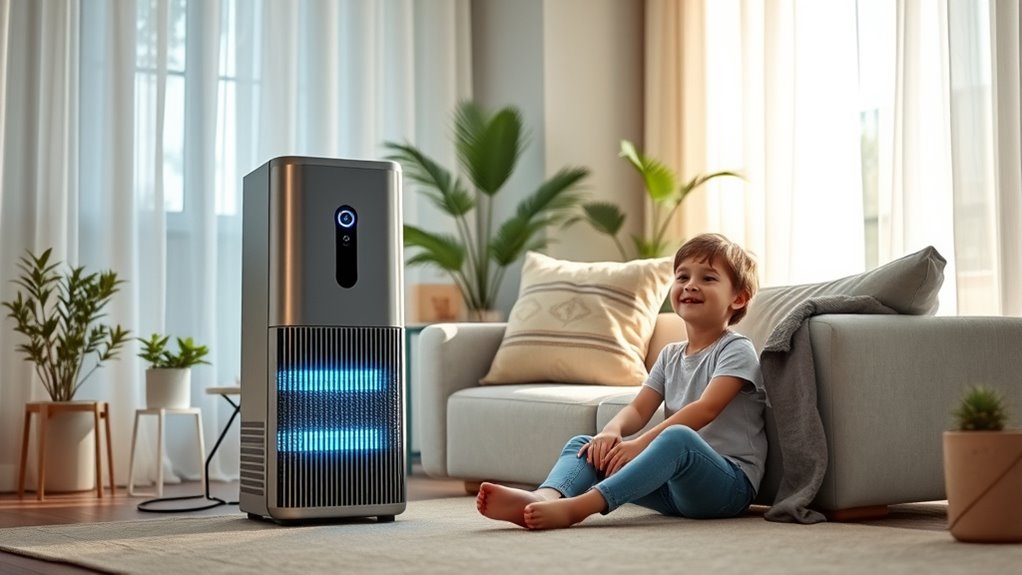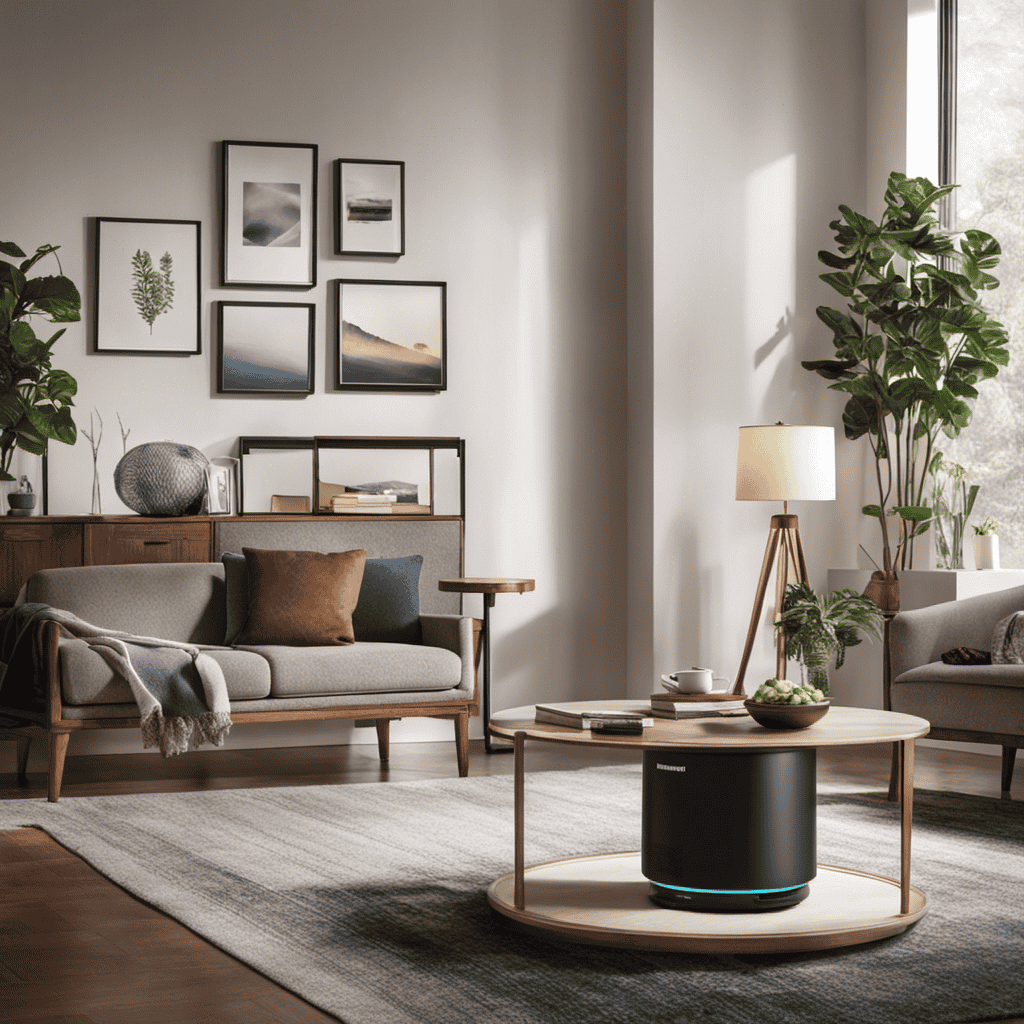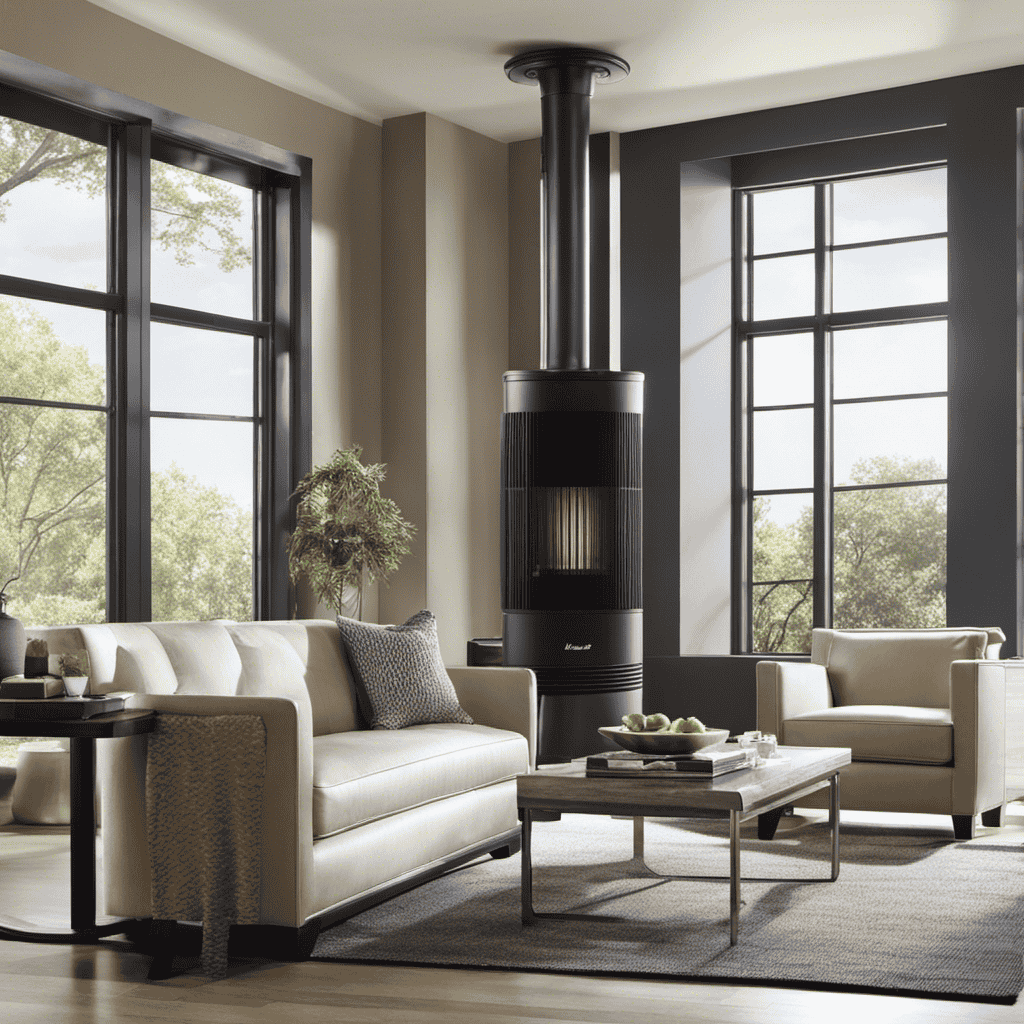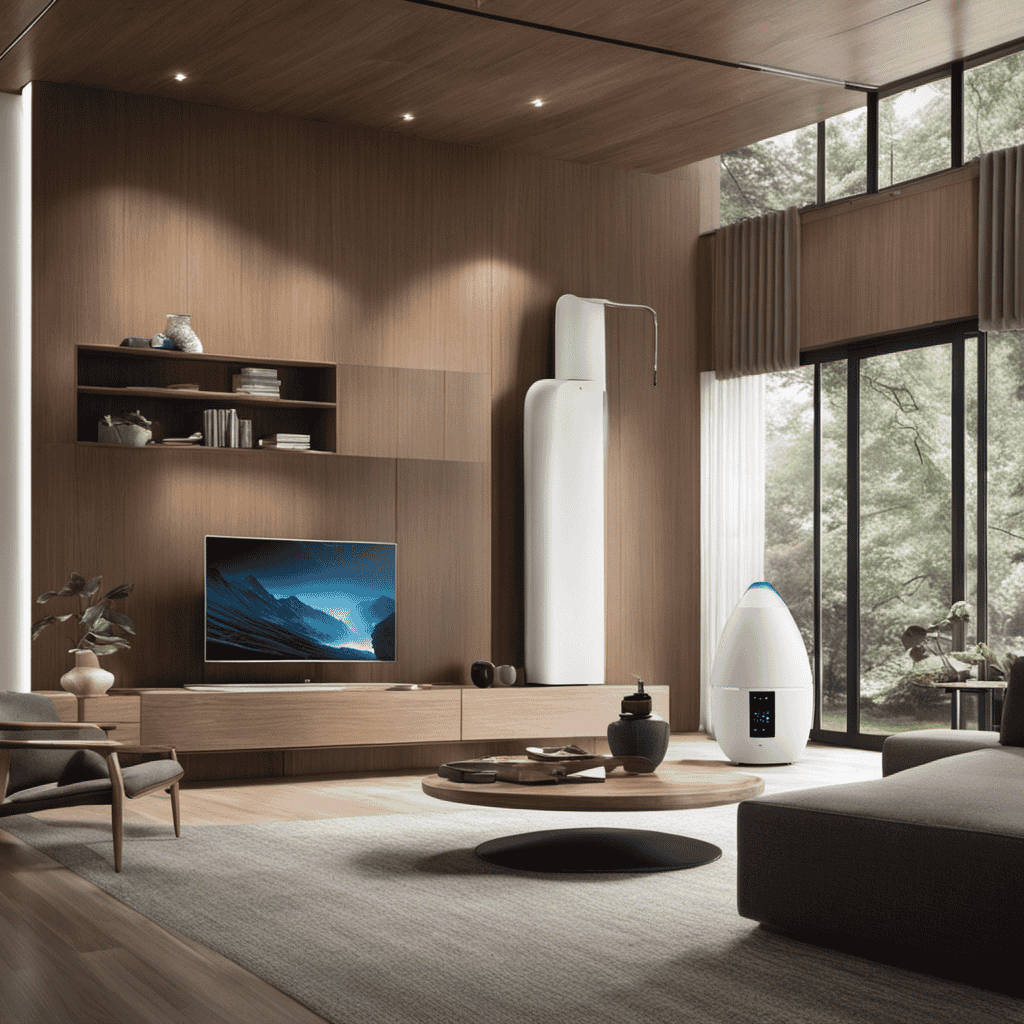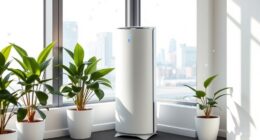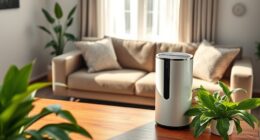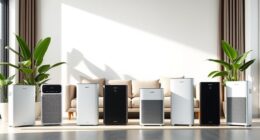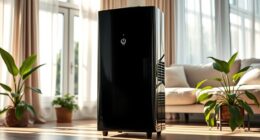Air purifiers can substantially ease your asthma symptoms by removing airborne allergens like dust, pollen, pet dander, and mold spores. High-efficiency HEPA filters trap tiny particles, while activated carbon filters eliminate odors and irritant gases. Regular use and proper maintenance improve indoor air quality, reducing triggers and helping you breathe easier. To learn how to optimize your environment and manage asthma effectively, discover more tips below.
Key Takeaways
- Air purifiers remove common airborne asthma triggers like dust, pollen, pet dander, and mold spores, reducing symptom severity.
- Using HEPA filters in air purifiers effectively captures small particles that worsen asthma, improving lung function.
- Activated carbon filters eliminate odors and VOCs, decreasing indoor irritants that can trigger asthma attacks.
- Consistent air purifier use creates a cleaner indoor environment, leading to fewer asthma symptoms and better overall control.
- Proper maintenance and appropriate sizing ensure optimal performance, maximizing health benefits for asthma sufferers.
Understanding Asthma and Common Triggers
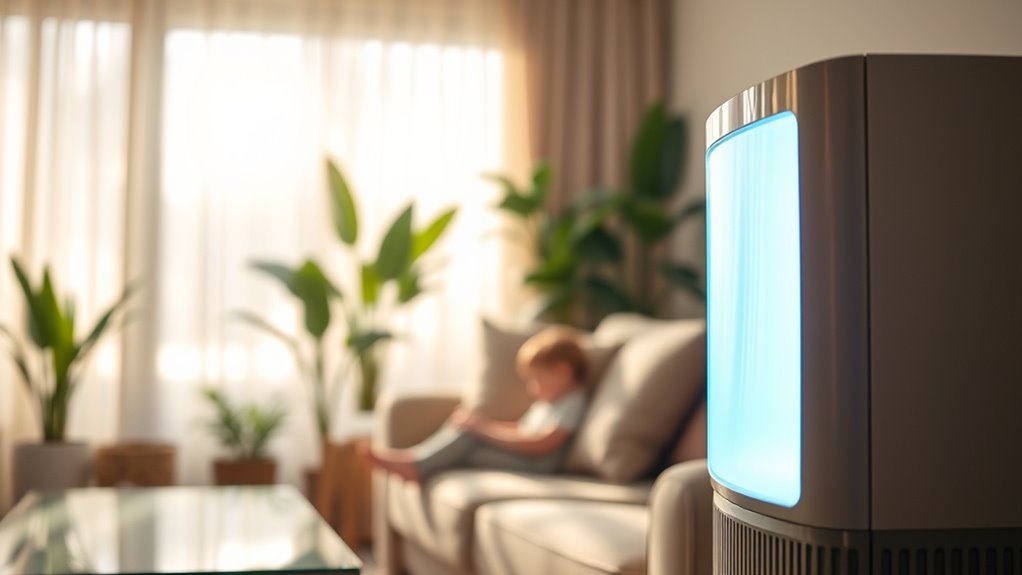
Asthma is a chronic condition that affects your airways, making it difficult to breathe when triggered. You need to be aware of common triggers like indoor humidity levels and allergens. Too much humidity can encourage mold growth and dust mites, worsening your symptoms. Maintaining ideal indoor humidity—around 30-50%—helps prevent these issues. Allergen avoidance is essential; keep your living space free of dust, pet dander, and mold. Regular cleaning, using dust-proof covers, and minimizing clutter reduce allergen buildup. Ventilate rooms properly to control humidity and reduce stale air. Recognizing these triggers allows you to manage your environment better, reducing asthma attacks. By controlling indoor humidity and avoiding allergens, you create a safer space that supports better breathing and overall asthma management. Additionally, understanding the role of air quality can help you identify other environmental factors that may influence your symptoms. Monitoring indoor air quality with air purifiers can further improve your respiratory health. Proper ventilation and air purification work together to reduce airborne irritants and allergens, further supporting asthma control. Using advanced air purification technology can also provide more comprehensive protection against irritants and allergens in your environment.
How Air Purifiers Work to Improve Indoor Air Quality
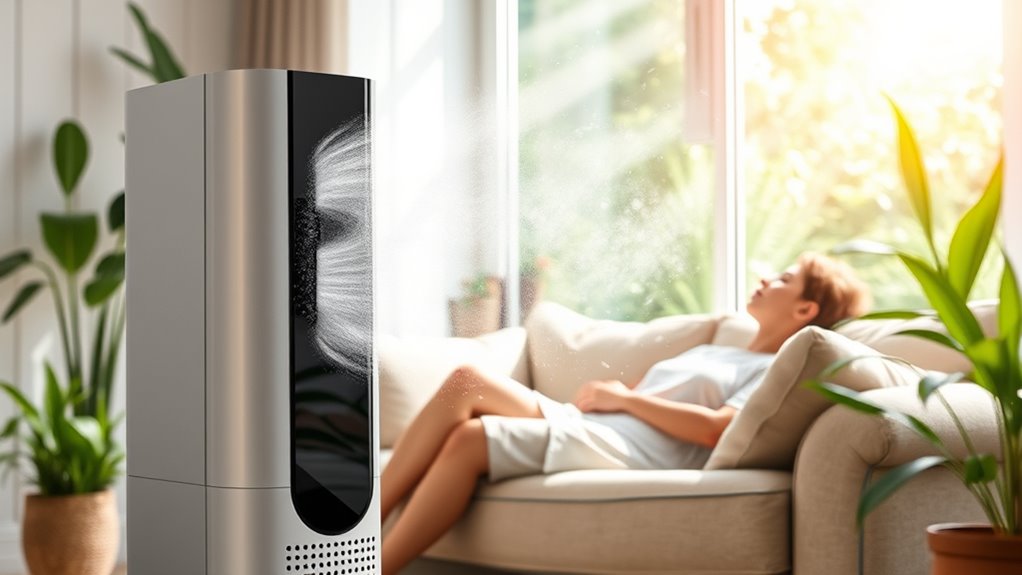
Air purifiers work by actively pulling indoor air through filters that trap airborne pollutants, such as dust, pollen, pet dander, and mold spores. To keep your air purifier functioning effectively, regular air purifier maintenance is essential. This includes cleaning or replacing filters as recommended by the manufacturer. Proper maintenance ensures the device continues to filter pollutants efficiently, improving your indoor air quality. Additionally, using air quality monitoring devices can help you track pollutant levels and identify when your purifier needs attention. By consistently maintaining your air purifier and monitoring air quality, you can maximize its benefits, creating a cleaner, healthier environment that may reduce asthma symptoms and improve overall comfort indoors. Furthermore, understanding the legacy of explorers can inspire a proactive approach to exploring and maintaining your indoor environment for optimal health benefits. Regularly inspecting your purifier and staying informed about new technologies can further enhance its performance and your indoor air quality. Staying updated on advancements in filter materials can also help you select more effective products for your needs. Incorporating models with HEPA filtration can significantly boost allergen removal, ensuring cleaner air and better symptom relief.
Types of Air Purifiers Suitable for Asthma Sufferers
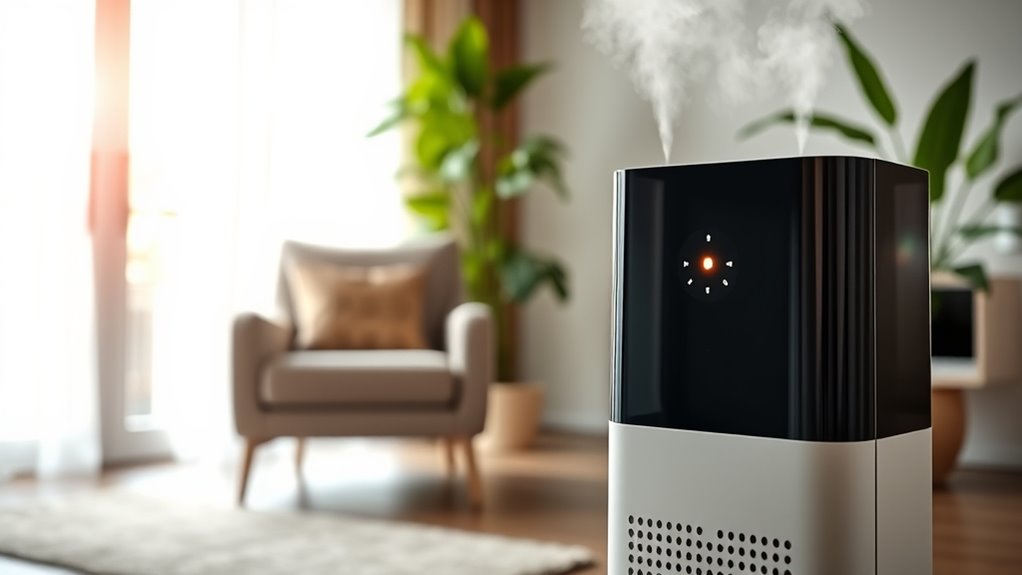
Choosing the right air purifier is essential for those with asthma, as some models are better equipped to remove specific triggers and allergens. Look for devices with quiet operation, since air purifier noise can disrupt sleep or daily activities. Many asthma-friendly purifiers feature low noise levels, making them suitable for bedrooms and living spaces. Also, consider energy consumption; some models run efficiently without markedly increasing your electricity bill. Energy-efficient air purifiers use less power while maintaining strong filtration, which is important if you plan to run them continuously. Select a model that balances effective air cleaning with low noise and energy use. Proper air tuning of the purifier can optimize its performance and ensure the best relief from asthma triggers without added inconvenience or cost. Additionally, air quality monitoring features can help you assess and adjust settings for optimal allergen removal. Regular maintenance and filter replacement are also crucial for maintaining the purifier’s effectiveness and ensuring consistent air quality.
The Role of HEPA Filters in Reducing Allergens
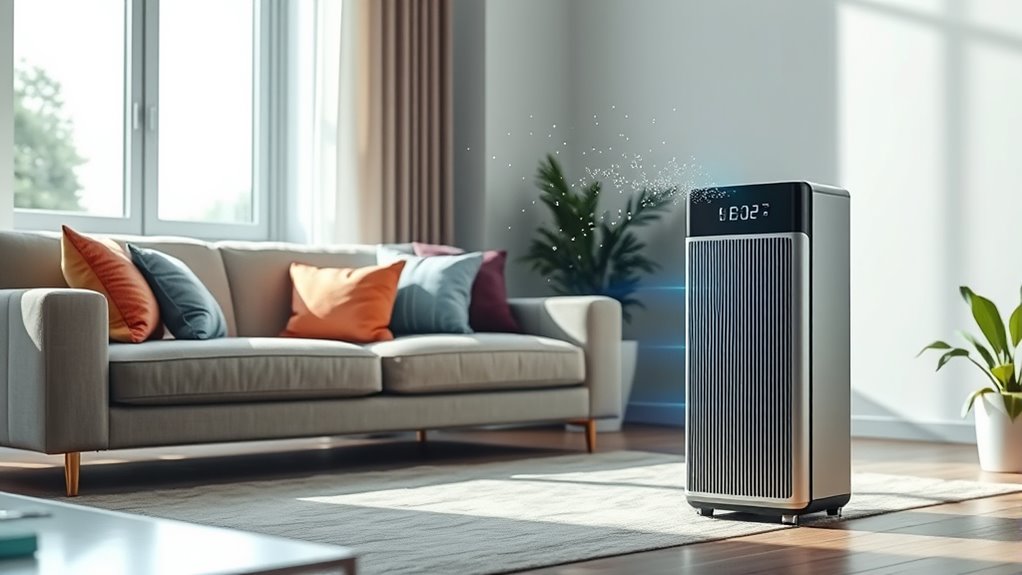
Have you ever wondered how HEPA filters can make a difference in your allergy relief? These filters are designed to trap tiny particles like pollen, pet dander, and dust mites, which are common asthma triggers. HEPA filters excel at allergen reduction, helping you breathe easier and reducing allergy symptoms. To visualize their effectiveness, consider this table:
| Particle Size | Filter Capability |
|---|---|
| 0.3 microns | Captures 99.97% |
| Pollen | Removed |
| Dust mites | Reduced |
| Pet dander | Effectively trapped |
| Mold spores | Eliminated |
Using air purifiers with HEPA filters can markedly cut allergen levels in your environment, providing relief and improving your quality of life. hepa filters are especially effective at capturing microscopic particles that trigger asthma symptoms. Incorporating air purifier technology into your daily routine can further enhance indoor air quality and allergen removal. Additionally, understanding the importance of proper filtration can help you select the best air purifier for your needs. Proper maintenance and filter replacement are essential to ensure ongoing effectiveness and optimal air purification efficiency.
Effectiveness of Activated Carbon Filters in Removing Irritants

Activated carbon filters are highly effective at removing irritants from the air. They absorb volatile organic compounds (VOCs) and eliminate odors and gases that can trigger asthma symptoms. Using these filters can markedly improve your indoor air quality and comfort.
Absorbs Volatile Organic Compounds
Since volatile organic compounds (VOCs) can considerably worsen asthma symptoms, removing them from indoor air is essential. Activated carbon filters excel at absorbing these airborne irritants, which are common indoor pollutants. The porous nature of activated carbon provides a large surface area, trapping volatile compounds effectively. When you use an air purifier with activated carbon, it reduces the concentration of harmful gases like formaldehyde, benzene, and toluene, all of which can trigger asthma attacks. This absorption process helps create a cleaner, safer breathing environment. The adsorption capacity of activated carbon makes it especially effective for continuous removal of irritants. Additionally, the filter maintenance process is crucial to prevent clogging and maintain optimal efficiency. Proper air circulation also enhances the removal of VOCs, ensuring the air remains healthier for asthma sufferers. Keep in mind, these filters are especially beneficial in homes with new furniture, paints, or cleaning products that emit VOCs. By targeting these irritants, activated carbon filters play a vital role in managing asthma symptoms. Necessary cookies are also used to ensure the proper functioning of the site and improve user experience. Additionally, understanding the significance of air quality improvement can motivate more effective use of filtration systems in asthma management.
Eliminates Odor and Gases
Because odors and airborne gases can critically impact indoor air quality and trigger asthma symptoms, removing them is essential. Activated carbon filters excel at odor elimination and gas removal, making your air cleaner and safer. These filters trap volatile organic compounds (VOCs), fumes, and other irritants that can worsen asthma. As air passes through the activated carbon, harmful gases are adsorbed, reducing unpleasant smells and chemical irritants. Additionally, filter lifespan in the filtration process ensures consistent removal of pollutants, enhancing the overall effectiveness of your air purifier. Proper maintenance of these filters is vital to sustain their efficiency and ensure continuous protection. Regularly replacing or regenerating the filters prolongs their performance, maintaining high levels of gas and odor removal. With effective gas removal and odor elimination, your air purifier helps create a healthier environment. You’ll notice fresher air, fewer irritants, and a reduction in asthma symptoms, making your living space more comfortable and safer.
Factors to Consider When Choosing an Air Purifier for Asthma
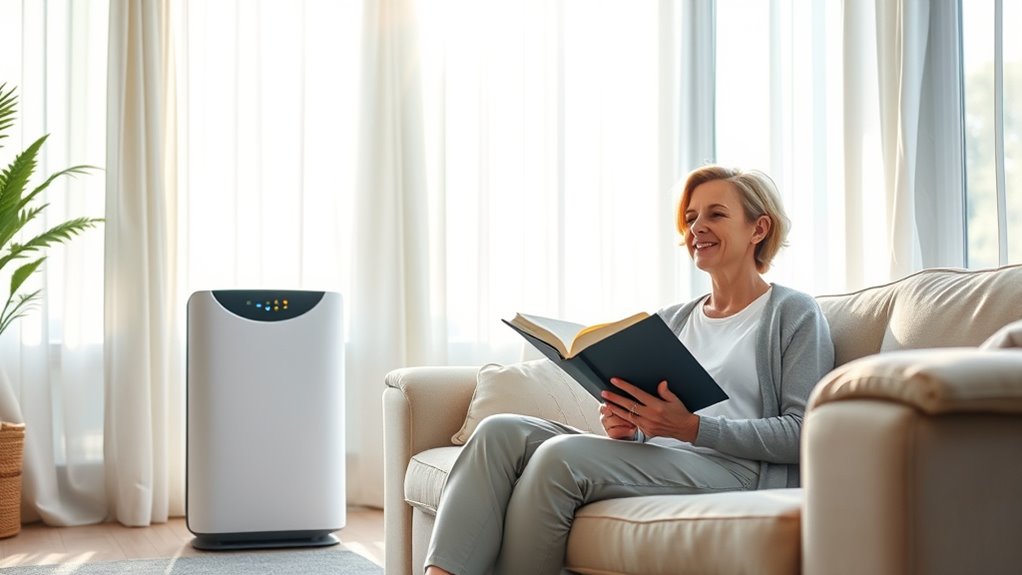
When choosing an air purifier for asthma, you need to take into account the filter type to guarantee it effectively removes irritants. Make sure the purifier’s size matches your room to maximize its performance. These factors can make a big difference in improving your indoor air quality. For optimal results, consider models with HEPA filtration, which are highly effective at capturing airborne particles that can trigger asthma symptoms. Additionally, understanding AI-driven personalization in e-learning techniques can help manage emotional stress that may exacerbate asthma, as stress can influence respiratory health. Implementing performance tuning strategies like adjusting air purifier settings based on your environment can further optimize air quality and reduce asthma triggers. Staying informed about advances in AI security can also ensure your smart devices operate safely and do not inadvertently introduce new allergens or vulnerabilities into your environment.
Filter Type Compatibility
Choosing the right air purifier for asthma begins with understanding filter types and their compatibility with your needs. Not all filters are created equal, so check if the purifier’s filter compatibility matches your specific concerns, like dust, pollen, or pet dander. HEPA filters are highly recommended for asthma sufferers because they capture small particles effectively. Consider the filter lifespan as well; some filters need replacing every few months, while others last longer. This impacts maintenance and ongoing costs. Make sure the filter type suits your allergy triggers and lifestyle. A compatible, durable filter ensures your air purifier continually provides clean, allergen-free air without frequent replacements, helping you breathe easier and manage asthma symptoms more effectively.
Air Purifier Size
Selecting the right size air purifier guarantees it effectively cleans the air in your space without wasting energy or space. The air purifier size should match your room’s dimensions to ensure ideal performance. If it’s too small, it won’t filter the air efficiently, leaving asthma triggers behind. Conversely, an oversized unit may consume unnecessary energy and generate excess noise, disrupting bedroom comfort. Measure your room accurately before choosing. For bedrooms, aim for an air purifier with a CADR (Clean Air Delivery Rate) suitable for the room’s size. Proper sizing ensures cleaner air, reduces allergens, and promotes restful sleep. When you select the right size, you create a healthier environment, which is essential for managing asthma symptoms effectively.
Scientific Evidence Supporting the Use of Air Purifiers for Asthma Relief
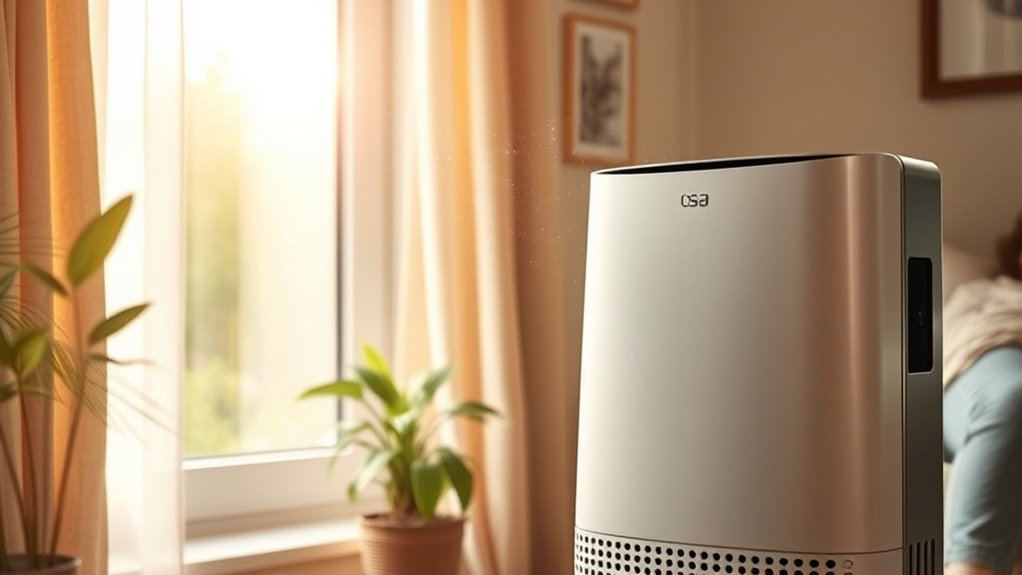
Research shows that air purifiers can effectively reduce airborne allergens and pollutants that trigger asthma symptoms. Numerous studies support their use, showing significant improvements in lung function and reduced asthma attacks. However, it’s important to take into account factors like air purifier noise, which can affect your comfort, especially during sleep. While some models operate quietly, others may be louder, so choose one that fits your environment. Additionally, cost considerations matter; high-quality air purifiers with HEPA filters can be pricey upfront but often deliver better results and durability. Overall, scientific evidence indicates that air purifiers can be a valuable tool in managing asthma, but balancing effectiveness with noise levels and budget will help you make the best choice for your needs.
Proper Placement and Maintenance of Air Purifiers
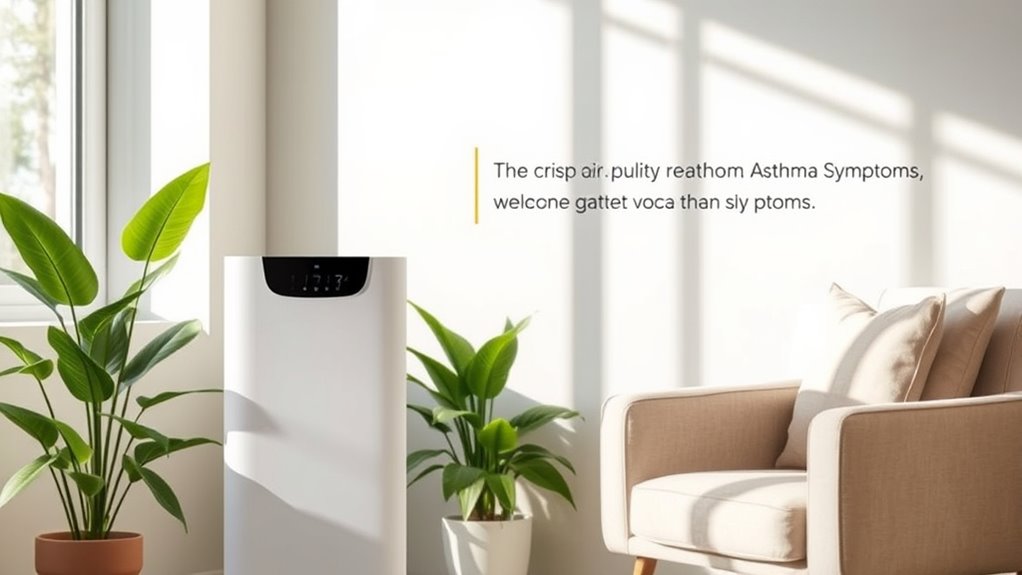
To maximize the benefits of your air purifier, proper placement and regular maintenance are essential. Place your air purifier in a central location, ideally on a level surface, and avoid blocking air vents with furniture or curtains. Keep it away from walls, electronics, and sources of moisture to guarantee optimal airflow. Proper air purifier placement allows it to effectively filter the air in your space. Additionally, establish a maintenance routine by regularly checking and replacing filters as recommended by the manufacturer. Clean the exterior and pre-filters periodically to prevent dust buildup. A consistent maintenance routine keeps your air purifier functioning efficiently and prolongs its lifespan. By paying attention to placement and maintenance, you maximize its ability to reduce airborne irritants and improve your asthma symptoms.
Complementary Strategies for Managing Asthma Symptoms
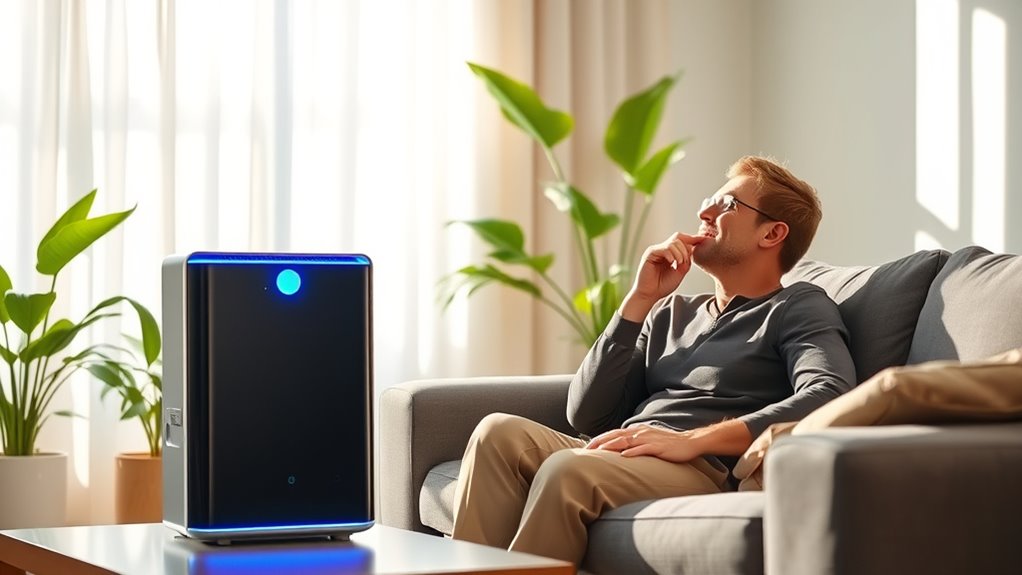
In addition to maintaining your air purifier, incorporating complementary strategies can further help manage your asthma symptoms. Simple steps like avoiding triggers, staying active, and practicing breathing exercises can make a big difference. Be mindful of air purifier noise, which might disrupt sleep or relaxation, and consider quieter models if needed. Cost considerations are important—investing in basic air filters or allergy-proof bedding can be cost-effective options. Remember, managing asthma requires a holistic approach. Here’s a quick overview:
| Strategy | Emotional Benefit |
|---|---|
| Avoiding triggers | Feeling safer and more in control |
| Breathing exercises | Gaining calm and confidence |
| Cost-conscious choices | Reducing stress over expenses |
These strategies empower you to take control and improve your quality of life.
Real-Life Experiences and Benefits Reported by Asthma Patients
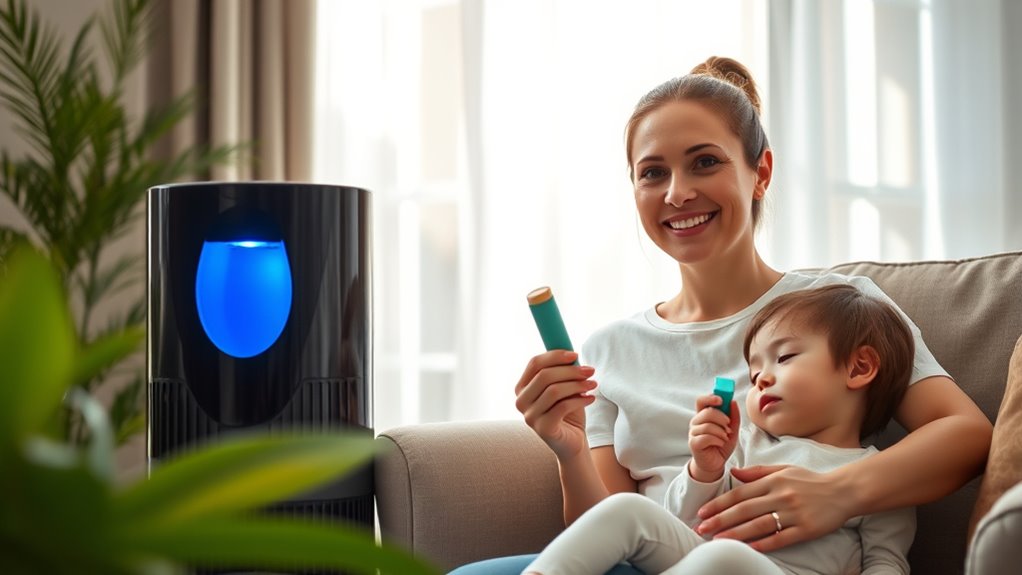
Many asthma patients find that implementing complementary strategies, like breathing exercises and trigger avoidance, leads to noticeable improvements in their daily lives. Many report that using air purifiers has markedly reduced allergy triggers and indoor pollutants, making breathing easier. However, some mention concerns about air purifier noise disrupting sleep or daily activities, so choosing a quieter model can make a big difference. Cost considerations are also important; while high-quality air purifiers can be an investment, many patients find the benefits outweigh the expense, especially with lower energy bills and improved health. Overall, real-life experiences highlight that air purifiers can provide meaningful relief, but evaluating noise levels and costs helps ensure you select the right device for your needs.
Frequently Asked Questions
Can Air Purifiers Completely Eliminate Asthma Triggers Indoors?
You might wonder if air purifiers can completely eliminate asthma triggers indoors. While they markedly reduce indoor allergens like dust, pet dander, and mold, they don’t remove every trigger. To maximize benefits, use air quality monitoring to track improvements and identify remaining issues. Regular cleaning and proper ventilation complement air purifier use, helping create a healthier environment, though complete elimination of triggers isn’t always possible.
How Often Should I Replace Filters in My Air Purifier?
You should replace your air purifier filters based on the filter lifespan and your usage. Typically, manufacturers recommend a replacement schedule of every 3 to 6 months, but this can vary depending on air quality and filter type. Check your unit’s instructions regularly and inspect filters for dirt or clogging. Staying on top of filter replacement guarantees your purifier works efficiently, helping reduce asthma triggers indoors.
Are Air Purifiers Noisy Enough to Disturb Sleep?
You might wonder if air purifiers are noisy enough to disturb sleep. Many models produce a soothing white noise that actually helps mask disruptive sounds, promoting better sleep. However, some purifiers can be louder, causing sleep disruption. To avoid this, choose a quieter, sleep-friendly model with adjustable settings. That way, you get clean air without sacrificing restful sleep, and the white noise can even help you relax.
Do Portable Air Purifiers Cover Large Rooms Effectively?
Imagine your comfort as a gentle breeze soothing your space. Portable air purifiers, with the right purifier power, can effectively cover large rooms when matched to the room size. While some models excel in spacious areas, others are better suited for smaller spaces. Always check the purifier’s specifications to guarantee it’s designed for your room size, so you enjoy cleaner air and peace of mind throughout your entire room.
Can Air Purifiers Help With Asthma Caused by Outdoor Pollution?
You might wonder if air purifiers can help with asthma caused by outdoor pollution. They can be effective because they filter out outdoor pollution particles that act as asthma triggers. When you use a high-quality air purifier, it reduces airborne pollutants indoors, providing relief from outdoor pollution’s harmful effects. While they aren’t a cure, air purifiers can considerably improve your indoor air quality and help manage asthma symptoms linked to outdoor triggers.
Conclusion
So, after all this, it’s almost ironic—air purifiers might just be your best bet against asthma triggers, yet many overlook them. You’d think avoiding allergens would be enough, but sometimes, the air itself needs a little help. With the right purifier, proper placement, and some simple habits, you can breathe easier. Ironically, the very device designed to clean your air might be your secret weapon in managing asthma—who would’ve guessed?
